INTRO
REGION
LINKS
SHOPS
EVENTS
|
|
HOME INTRO |
VISIT REGION |
MEDIA LINKS |
TOUR SHOPS |
NEWS EVENTS |
|---|---|---|---|---|---|
EBT Fall Spectacular 1996 / FEBT 14th Reunion | |||||
< Back to the EBTRR Homepage
< Back to the EBTRR Multimedia Archive
Page Contents:
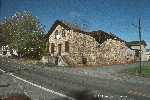 The 1874 Company Store
in Robertsdale is looking pretty bad in this shot. It
has been condemned and will be gone within 6 months.
The 1874 Company Store
in Robertsdale is looking pretty bad in this shot. It
has been condemned and will be gone within 6 months.
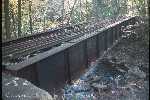 Rocky Ridge Bridge is a good
walk from the nearest road. This is the first
of several crossings of Trough Creek between
Wrays Hill Tunnel and the
coal fields.
Rocky Ridge Bridge is a good
walk from the nearest road. This is the first
of several crossings of Trough Creek between
Wrays Hill Tunnel and the
coal fields.
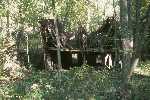 Rocky Ridge Station is
just short of Wrays Hill Tunnel.
This is its last stand and in the winter of 1998 it will collapse.
Rocky Ridge Station is
just short of Wrays Hill Tunnel.
This is its last stand and in the winter of 1998 it will collapse.
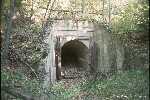 Wrays Hill Tunnel is a
few hundred feet from the bridge and is where the
railroad moves completely out of the Aughwick Creek watershed.
Wrays Hill Tunnel is a
few hundred feet from the bridge and is where the
railroad moves completely out of the Aughwick Creek watershed.
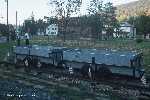 Two restored mine cars stand on a short section of track a short distance from
the Saltillo Station. The cars would
not have worked here and likely came from Robertsdale or Woodvale.
Two restored mine cars stand on a short section of track a short distance from
the Saltillo Station. The cars would
not have worked here and likely came from Robertsdale or Woodvale.
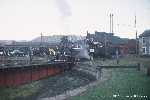 #15 is on its way into the Roundhouse
after a day's work on Saturday. Coach
#8, a combine and Parlor car #20 are parked behind it. The Red building is the
Blacksmith Shop.
#15 is on its way into the Roundhouse
after a day's work on Saturday. Coach
#8, a combine and Parlor car #20 are parked behind it. The Red building is the
Blacksmith Shop.
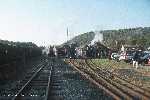 #17, #15 and #14 are lined up to take successive trains down the line.
#17, #15 and #14 are lined up to take successive trains down the line.
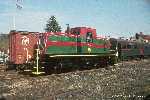 The M-7 GE diesel switcher on display in the
Rockhill Yard. It was called into
rescue service late Sunday when #15 split the
Colgate Grove switch with one of
its caboose's trucks while backing around.
The M-7 GE diesel switcher on display in the
Rockhill Yard. It was called into
rescue service late Sunday when #15 split the
Colgate Grove switch with one of
its caboose's trucks while backing around.
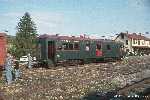 The M-1 gas-electric on display in the
Rockhill Yard. It was making two
runs each day for holders of the special M-1 ride tickets.
The M-1 gas-electric on display in the
Rockhill Yard. It was making two
runs each day for holders of the special M-1 ride tickets.
 This view is of locomotives #17 and #15 through the unused hoppers in the
Rockhill Yard. A picture of what
was, framing what can be.
This view is of locomotives #17 and #15 through the unused hoppers in the
Rockhill Yard. A picture of what
was, framing what can be.
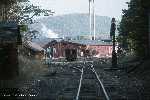 Looking from the end of the operating line to the south, toward the shops.
Looking from the end of the operating line to the south, toward the shops.
 This is a view from the coaling docks
built into the side of the hill at
the south end of the yard. #12 has just backed out from the
Roundhouse and
#15 is backing around the wye with a passenger train.
This is a view from the coaling docks
built into the side of the hill at
the south end of the yard. #12 has just backed out from the
Roundhouse and
#15 is backing around the wye with a passenger train.
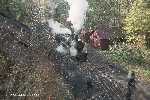 #12 has backed through the switch onto the main and is now approaching us. #15 is
dropping off its passenger train, picking up a flatcar freight, and then will
return here to add #12 onto it's front for a doubleheader.
#12 has backed through the switch onto the main and is now approaching us. #15 is
dropping off its passenger train, picking up a flatcar freight, and then will
return here to add #12 onto it's front for a doubleheader.
 #12 has coupled onto #15 and together they are moving through the yard.
#12 has coupled onto #15 and together they are moving through the yard.
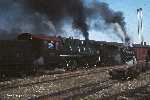 They are on their way to take up position behind #17, which has a mixed freight
at Orbisonia Station. #14 has already
started down the line with a passenger
train.
They are on their way to take up position behind #17, which has a mixed freight
at Orbisonia Station. #14 has already
started down the line with a passenger
train.
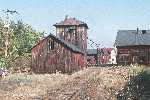 The Sand House, though not operational,
still holds a supply of sand.
The Sand House, though not operational,
still holds a supply of sand.
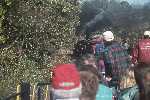 We're now on the doubleheaded freight. We've passed the
Runk Road Bridge and
are entering the S curve at
Douglas Summit.
We're now on the doubleheaded freight. We've passed the
Runk Road Bridge and
are entering the S curve at
Douglas Summit.
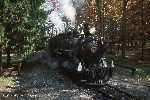 We are passing the south leg of the
Colgate Grove Wye. #14 has backed
and pulled forward through the wye and is waiting for the line to be clear. #17
has backed through the wye and is waiting on the east tail for #14 to proceed.
We are passing the south leg of the
Colgate Grove Wye. #14 has backed
and pulled forward through the wye and is waiting for the line to be clear. #17
has backed through the wye and is waiting on the east tail for #14 to proceed.
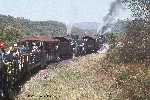 #14 and #17 have left the wye in sequence and we are backing through the
north leg into the position last held by #17.
#14 and #17 have left the wye in sequence and we are backing through the
north leg into the position last held by #17.
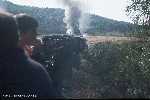 We've passed through the wye and are moving through the S curve again, this
time southbound.
We've passed through the wye and are moving through the S curve again, this
time southbound.
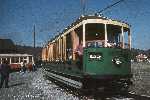 Back at Rockhill now, we're viewing one of the Rockhill Trolley Museum's
streetcars departing for "Blacklog" down the
Shade Gap Branch remnant.
Back at Rockhill now, we're viewing one of the Rockhill Trolley Museum's
streetcars departing for "Blacklog" down the
Shade Gap Branch remnant.
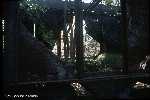 One can see clear through the most decayed hopper in
the yard, on the old Coach House
track. It is a poignant reminder that the
EBT is not a stable treasure.
One can see clear through the most decayed hopper in
the yard, on the old Coach House
track. It is a poignant reminder that the
EBT is not a stable treasure.
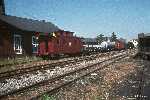 The next mixed freight heads for
Orbisonia Station, then to
Colgate Grove.
The next mixed freight heads for
Orbisonia Station, then to
Colgate Grove.
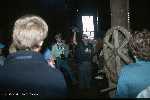 This is the beginning of the Rockhill EBT shops tour. We are in the
Foundry
and one of the Railways to Yesterday trolley museum volunteers is giving a fine
tour. He's holding a wood casting pattern for a mine cart wheel. He's explaining
how it was used to create a mold with special sand, into which the molten iron
was poured.
This is the beginning of the Rockhill EBT shops tour. We are in the
Foundry
and one of the Railways to Yesterday trolley museum volunteers is giving a fine
tour. He's holding a wood casting pattern for a mine cart wheel. He's explaining
how it was used to create a mold with special sand, into which the molten iron
was poured.
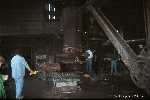 This is a view of the interior of the
Foundry. The tall iron furnace is in the
center and a small brass furnace is behind the people at the right. The tubes
on the main furnace injected the heated air and the metal exited from the waist-level
hole in the front. At the far right is a 360 degree pivoting gantry used to move
sand castings to and from the furnace for pouring.
This is a view of the interior of the
Foundry. The tall iron furnace is in the
center and a small brass furnace is behind the people at the right. The tubes
on the main furnace injected the heated air and the metal exited from the waist-level
hole in the front. At the far right is a 360 degree pivoting gantry used to move
sand castings to and from the furnace for pouring.
 This is the large drill press in the
Machine Shop used for wheel boring. It was
run from the overhead belt system.
This is the large drill press in the
Machine Shop used for wheel boring. It was
run from the overhead belt system.
 The intrepid M-4, parked in the locomotive
Service Bays, did not venture
out this spectacular. Instead she kept the unrestored diesels company.
Among them are three M-7 duplicates, a MOW vehicle, a Plymouth diesel
and a couple gas engine crew cars.
The intrepid M-4, parked in the locomotive
Service Bays, did not venture
out this spectacular. Instead she kept the unrestored diesels company.
Among them are three M-7 duplicates, a MOW vehicle, a Plymouth diesel
and a couple gas engine crew cars.
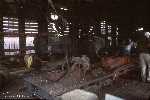 In the Boiler Shop, the
two crew cars are in the foreground and a huge combination steel sheet
punch and shear machine is in the background.
In the Boiler Shop, the
two crew cars are in the foreground and a huge combination steel sheet
punch and shear machine is in the background.
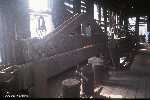 A steel sheet former basks in the sunlight.
A steel sheet former basks in the sunlight.
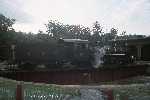 #12 is being put to bed for the winter after having dumped her ashes and having
her firegrate cleaned. She'll pull partially into her stall and open her cylinder
cocks to release the boiler steam and open her water line to drain the tender.
#12 is being put to bed for the winter after having dumped her ashes and having
her firegrate cleaned. She'll pull partially into her stall and open her cylinder
cocks to release the boiler steam and open her water line to drain the tender.
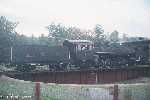 #17 has dumped her ashes and is about to push #12 into her stall. She will
then follow suite and open her cocks and water line as well.
#17 has dumped her ashes and is about to push #12 into her stall. She will
then follow suite and open her cocks and water line as well.
 A closeup view of one of the hopper trucks in the yard reveals the lettering
E B R R & C CO., revealing the company Vulcan cast it for. I guess they
thought Broad Top was one word.
A closeup view of one of the hopper trucks in the yard reveals the lettering
E B R R & C CO., revealing the company Vulcan cast it for. I guess they
thought Broad Top was one word.
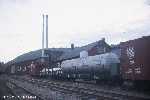 The mixed freight has been parked by the shop buildings for the winter. The
only wood-sided boxcar and tanker are visible.
The mixed freight has been parked by the shop buildings for the winter. The
only wood-sided boxcar and tanker are visible.
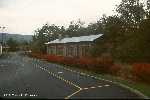 The Mount Union Engine House still
contains standard gauge switcher #3.
The Mount Union Engine House still
contains standard gauge switcher #3.
|
HOME |
The East Broad Top Railroad Homepage © 1994-2003 Christopher D. Coleman All rights reserved Site Information Top of this page |
|---|